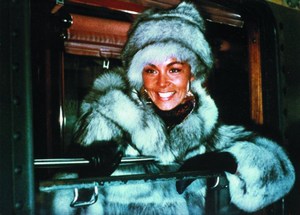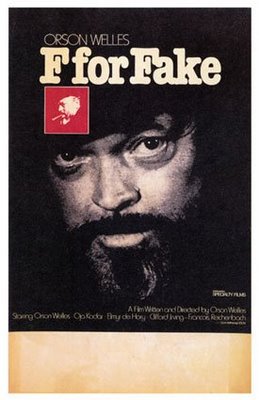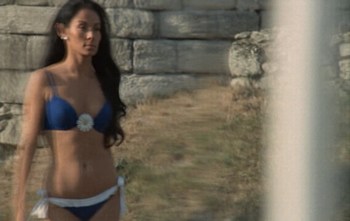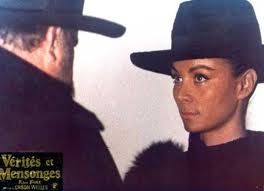|
film review "IT'S PRETTY, BUT IS IT ART?" A Review of Orson Welles' "Film Essay" F for Fake by Trevor Laurence Jockims Orson Welles’ final work as a director, the documentary What matters is trickery itself. So much so that Welles promises, twice, at the film’s beginning to tell only the truth in his film—for the first hour. 
Credited as the very first “film essay”, F for Fake has much in common with Dziga Vertov’s Man With a Movie Camera, released in 1929. Like Vertov, who is right there at the beginning of cinema exploring the possibilities of the medium, Welles is also at the edge of cinema, in 1974, thinking about what the medium can do. Welles is our host, our guide in this metafilm. There he sits: huge, bearded, and booming behind an editing machine, spinning tales about the movie he’s putting together right before our eyes. The film’s central figure is Elmyr de Hoya, “the greatest art forger in the world.” Welles charts Elmyr’s rise and fall and the role played in it all by Clifford Irving, the novelist-cum-biographer who brought the world’s attention to Elmyr with his 1969 book, Fake: The Story of Elmyr de Hoya, the Greatest Art Forger of Our Time. Elmyr’s career as a forger spans hundreds of canvases, works worth an untold sum, many of which likely still hang as the ostensible real things in major museums and galleries (and private collections) around the world. Elmyr, we are told, doesn’t copy paintings. He paints original works in the style of Picasso, Matisse, Modigliani, and so on, that then get passed off by dealers as the real thing, invariably passing the scrutiny—and receiving the validation of—world experts. Uncannily, Elmyr can mimic, down to a specific year, the style of a particular painter; his works are flawless fakes, and essentially no one can tell the difference. As Elmyr says in a rare philosophical moment, “If you hang them in a museum, in a collection of great paintings, and if they hang long enough there, they become real.” But Irving soon becomes more important to Welles than Elmyr. His latest book, an “autobiography” of eccentric tycoon Howard Hughes—who, among other things, had a hand in the early movie business himself—is based on interviews Irving conducted with the then-at-his-reclusive-zenith Hughes. Irving secured a huge fee from McGraw-Hill publishers for it, and the public whirlwind surrounding the book was enormous. This is all very fascinating, particularly when it becomes obvious that Irving has made the whole thing up. He never met Hughes. Besides a few forged letters from Hughes (which Irving based on photos he saw of actual letters once printed in a magazine), some copious “borrowing” from an unpublished biography of Hughes, and a remarkably brave imagination, Irving has nothing—or, rather, he has only an invented truth. An object everyone wants to take for the truth, despite its fakery. In other words, he has written an Elmyr. 
Welles admires these fakers a great deal, because he’s one of them. In addition to weaving himself into the film as its editor-host-bard, Welles tells two important stories about his own career, alongside the stories of these other fakers. The first concerns his journeys through Ireland as a young man, trying to sell his paintings, then trying to become an actor when painting did not pay. To land a job he lies to a theater company, telling them he’s a huge star back in New York, on Broadway no less. The second story is the well-known War of the Worlds incident in his career, when Welles gave a fake radio broadcast about a Martian invasion, causing much hysteria. Movie making is fakery of the highest kind, Welles seems to be telling us—could this be, in part, what is meant by the title “F for Fake,” an Alpha-Bravo-Charlie spelling out of the word “film”?—artifice being integral to any art, including—or, especially—his own. When Welles insists upon calling Elmyr “the second greatest faker of all time,” there are so many options for the number one slot that, by the time we reach the end of the film, it’s anybody’s guess who should receive that distinction. They’re all fair game, really—Welles, Irving, Hughes, and even the version of Picasso who comes in at the film’s end—but the best fake may perhaps finally be the medium of film itself. It’s certainly the most playful, compelling, and seductive of all the illusions we come across. This is a film, after all, in which Welles recites Kipling and also manages to nearly outdo the Chartres Cathedral itself, in a remarkable, impressionistic monologue-homage to it. It is one of the great moments of film that really does need to be seen to be believed. Beauty makes some important appearances in the film, one of which comes in the person of Oja Kodar, the Croatian beauty who acts as companion and magician’s assistant to Hughes throughout the film. Welles spent much of his final two decades with Kodar; there’s even a sculpture of him standing in the Croatian coastal city of Split, completed by Kodar herself and showing a version of Welles that might just as well have walked right off the set of F for Fake. 
In the film’s opening scenes, we watch Kodar walk—glide, really—down a city street. Actually, what we mostly watch is others watching her. She turns heads (to put it mildly), and the sight of her in a short skirt makes one really understand what short skirts can do. Certainly Kodar understands. The trick of the watchers whom we watch is that, as Welles happily tells us, none of them knows they are being watched. None of them knows they are being filmed. All they know is that Kodar is walking by. They don’t know they’re in a film. We watch them look and they don’t know we are looking at them. In this very early scene, a sort of prologue to the film, there’s nothing that is fake. As in Man With a Movie Camera, where Vertov goes on into the street to film Russian life as it happens in the streets, this is also cinema catching the real—if amped up with Eros. Or at least in the beginning it’s a close approximation of the real, given how vigorously and elegantly Welles edits, while in much of the rest of the film what he gives us is a scrupulously-arranged “real” (Welles and his team spent a year editing it, working seven days a week). Kodar, we are told at the film’s end, also used to walk by the window of Pablo Picasso in “the little village of Toussaint,” on her way to the beach in the morning, and again on her way home for lunch, then back to the beach, then for a siesta, and so on—all this in a swimsuit and tan. It was too much for poor Pablo, who eventually invited her in and asked her to sit for portraits. But Miss Kodar does not want to sit. She wants to be out in the sun. She strikes a deal with the great man: whatever he paints of her, she keeps. Picasso agrees and proceeds to paint some seventy-seven canvases, all of which Kodar hauls back home at summer’s end. Later, being no fool, Kodar takes her canvasses to Paris, where she puts on an exhibit. The exhibit receives great acclaim and causes an immense stir in the art world. Picasso has been born again! Genius! The fecundity! Picasso is enraged when he reads about the sensational Paris exhibit, since he and Kodar had agreed that the paintings were never to be sold or exhibited. To make matters worse, they aren’t even authentic Picassos. They’re fakes. Kodar’s grandfather—another great art forger, as great as Elmyr perhaps—has created copies for the exhibit. Kodar, still no fool, has kept the originals. 
“Twenty-two Picassos,” Welles muses in voiceover, and invites us to imagine their worth. Well, don’t imagine too much. The whole story is a fiction. A fake. Here our host looms back onto the screen to remind us of the promise he made at the beginning of the film to tell the truth—for the first hour. That hour, we learn, has expired. “For the past seventeen minutes,” Welles says with a smile, having delivered a masterpiece, “I’ve been lying my head off.”
anderbo.com fiction poetry "fact" photography masthead guidelines |